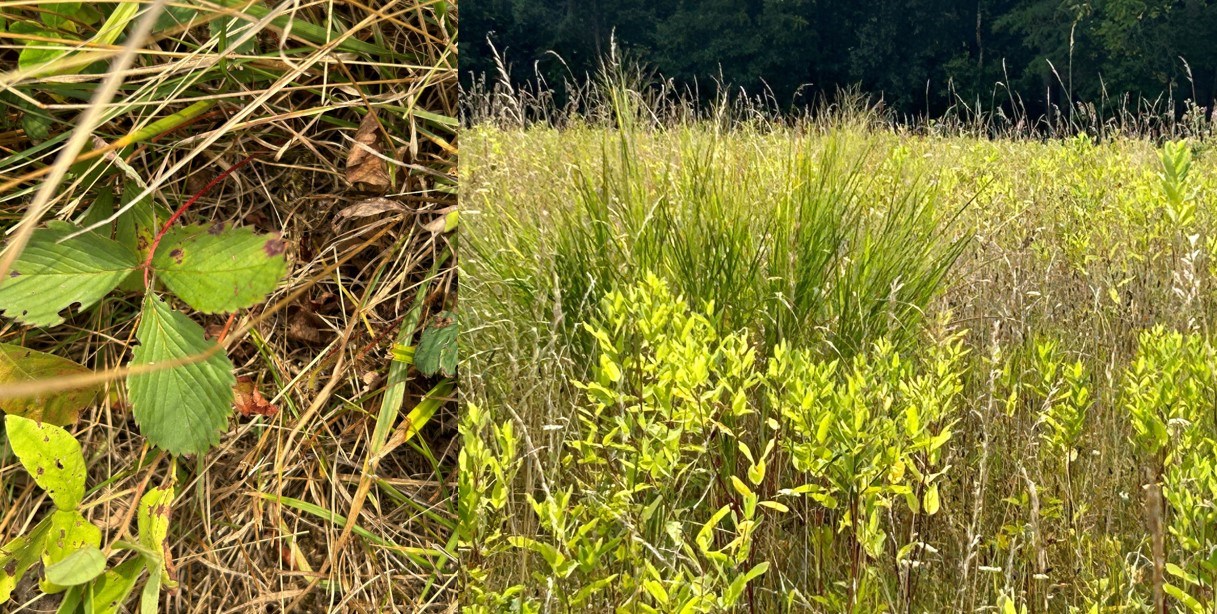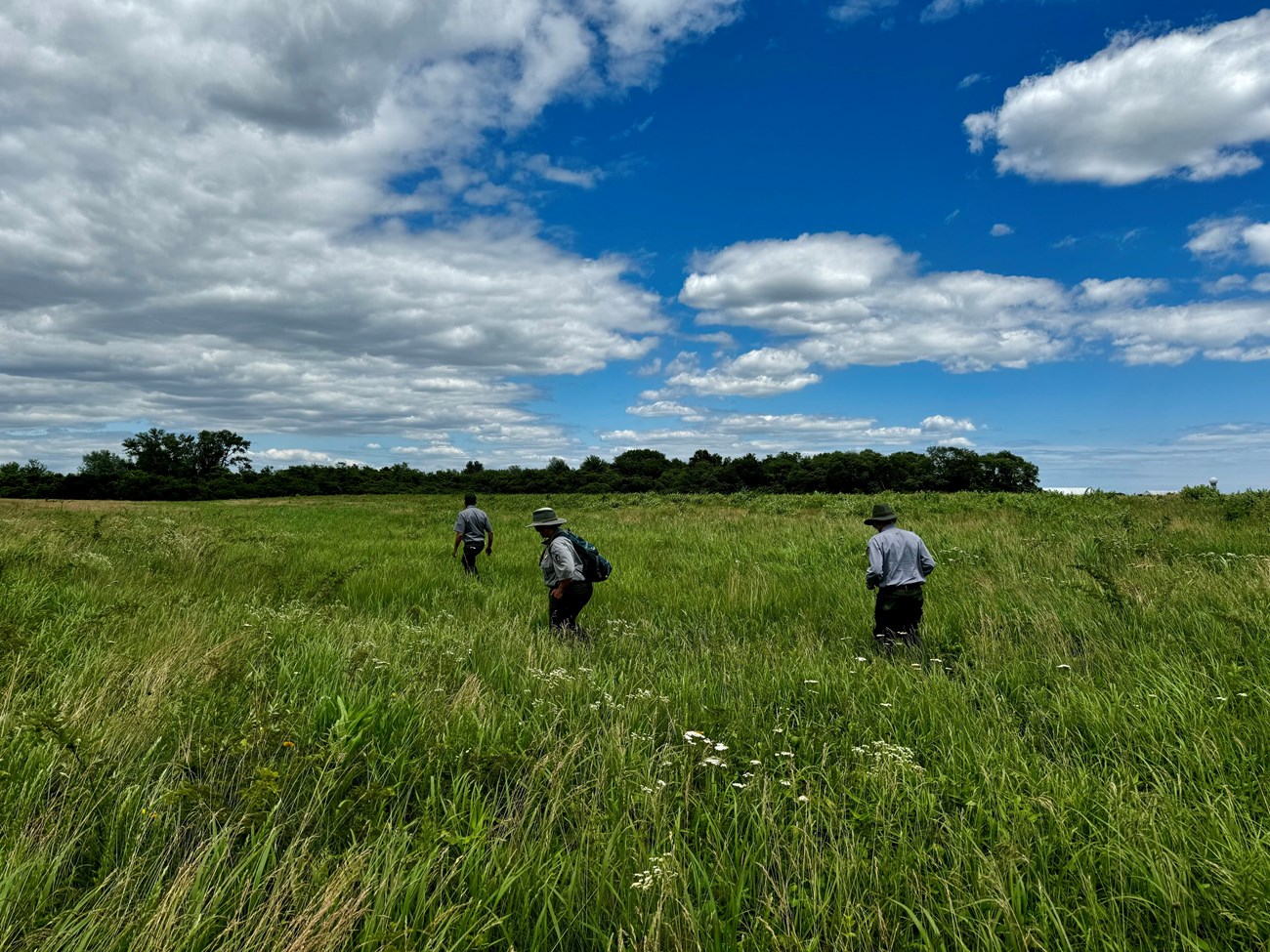Last updated: September 4, 2024
Article
Hidden in Plain Sight: Old Growth Remnant Grasslands

NPS
Unexpected Treasure
Imagine discovering that the cheap thrift store ceramic you’ve been using to keep your keys in is actually a priceless thousand-year-old Mayan vase. Now, instead of a vase, imagine you have a few acres of cow pasture and discovering that, despite its worn appearance, the land is actually an old growth remnant grassland that has existed for thousands of years. This ancient grassland has preserved most of the area’s original communities of plants, animals, and soil microorganisms including their unique genetic signature.
This is what happened in several national parks this summer during the initial phases of the National Park Service’s (NPS) work on a large grassland restoration project in the Eastern US funded by the Bipartisan Infrastructure Law and the Inflation Reduction Act.

NPS
What’s So Great About Remnant Grasslands?
Unlike an old growth forest of towering trees, old growth remnant grasslands are often hidden in plain sight because much of their story is told underground. Like the rings of a tree, the roots and soil reveal the age and history of ancient grasslands and the diverse plant communities they support. Grassland plants need to be disturbed to thrive and persist over time. At the surface, grazing, mowing, and burning may appear to damage the delicate vegetation, but these disturbances stimulate the plants to germinate, flower, and regrow. Plowing or tilling the soil in an old-growth grassland is like felling an ancient tree. Once the soil is disturbed, the grassland and its history are lost.
Finding an old growth remnant grassland requires skilled assessments of the resident plant community, site characteristics, and land-use history. These grasslands often host state and globally rare plant species, plants with specific soil and growing requirements, or species that take a long time to establish. Old-growth remnant grasslands are also incredibly biodiverse, and preserve some of the genetic diversity of the original grassland flora of the East. Conserving the genetics and local ecotypes of plant species present in these remnants is a key step towards restoring eastern grasslands.
According to Jeremy French, Director of Ecological Restoration and Stewardship with NPS collaborator Southeast Grasslands Institute, “if we can stabilize those [remnant] sites, make sure they persist, that gives us one of the best tools against climate change because it's allowing these long-term genetics more of an opportunity to not die off and to find their niche.”
Working to Restore Grasslands in the Eastern US
The 2024 field visits where old growth remnant grasslands were discovered are part of a larger project aimed at restoring eastern grasslands on up to 4,000 acres in 37 parks from Mississippi to Vermont.
Parks like Congaree, Great Smoky Mountains, and Shenandoah were already aware of their old-growth grasslands. However, for other parks, discovering these grasslands was an unexpected surprise. Previously, no old-growth grasslands were known to exist at Fredericksburg and Spotsylvania National Military Park, Rock Creek Park, or Gateway National Recreation Area. Even at Harpers Ferry National Historical Park and Manassas National Battlefield Park, where some old-growth remnant grasslands were known, new sites were located.
Most lands involved in the eastern grassland restoration project are currently agricultural fields or other degraded lands that have lost their native biodiversity. For those lands, the plan is to convert/reconstruct them into native grasslands by clearing the area and planting with a diverse mix of locally adapted native species. In contrast, old-growth remnant grasslands will be restored/rehabilitated using a lighter touch. In these areas, NPS and collaborators will strategically remove non-native and invasive plants and woody species. Instead of adding new species to the existing community, staff may collect and spread seed from existing plants within the remnant area to further enhance native diversity while maintaining the genetic diversity of the resident community. An important aspect of the project is reintroducing disturbance into the newly restored grassland ecosystems. Park staff will maintain the sites using a combination of mowing, prescribed fire, and targeted invasive plant treatments to ensure long-term success.

NPS/Casey Reese
Wait, Eastern Grasslands?!
It’s likely you’ve never considered the Eastern U.S. as a place with many grasslands. And at present, it’s true--there aren’t many native grasslands left. Prior to European settlement, tens of millions of acres of grasslands existed in the East. Today, less than 10% remain.
Eastern grasslands were hunted on and maintained by Indigenous people for thousands of years. Newly arrived Europeans saw their open expanses and rich soils as the easiest places to convert to settlement and agriculture. Most eastern grasslands did not last long and few thought to record their loss.
When most people think about grasslands today, they think about the Midwest. But most Midwestern grasslands only began to develop after climatic stabilization with the full retreat of glacial ice sheets 15,000 to 20,000 years before present day. Eastern and southeastern grasslands below New York, however, were never wiped clean by glaciation. Where some of these grasslands survive, they can be up to hundreds of thousands of years old, like the southeastern coastal plain savannas. They’re true old growth ecosystems, with incredible species biodiversity and endemism from long-term evolution and development.
That’s why the investment in grassland restoration made possible by the Bipartisian Infrastructure Law and Inflation Reduction Act is incredibly important. Restoring eastern grasslands not only restores the unique plant communities on the landscape, it supports rapidly declining populations of grassland birds, and pollinators, sustains nutrient cycling and carbon sequestration–storing up to 5 tons of carbon per acre, and maintains vital soil conditions and water quality. Intact native grassland ecosystems also reduce climate change vulnerability and stressors such as drought and extreme heat.
Like the Mayan vase hidden in plain sight, restoring eastern grasslands means re-discovering and retelling an important part of American history.
Tags
- antietam national battlefield
- appalachian national scenic trail
- big south fork national river & recreation area
- booker t washington national monument
- catoctin mountain park
- cedar creek & belle grove national historical park
- chesapeake & ohio canal national historical park
- chickamauga & chattanooga national military park
- congaree national park
- delaware water gap national recreation area
- flight 93 national memorial
- fort necessity national battlefield
- fredericksburg & spotsylvania national military park
- friendship hill national historic site
- gateway national recreation area
- george washington birthplace national monument
- gettysburg national military park
- great smoky mountains national park
- harpers ferry national historical park
- little river canyon national preserve
- mammoth cave national park
- manassas national battlefield park
- marsh - billings - rockefeller national historical park
- minute man national historical park
- monocacy national battlefield
- natchez trace parkway
- national capital parks-east
- new river gorge national park & preserve
- petersburg national battlefield
- richmond national battlefield park
- rock creek park
- saratoga national historical park
- shenandoah national park
- stones river national battlefield
- valley forge national historical park
- weir farm national historical park
- wolf trap national park for the performing arts
- grassland
- old growth
- old growth grassland
- old growth remnant grassland
- remnant grassland
- remnant
- restoration
- eastern grasslands
- southeastern grasslands
- inflation reduction act
- bipartisan infrastructure law
